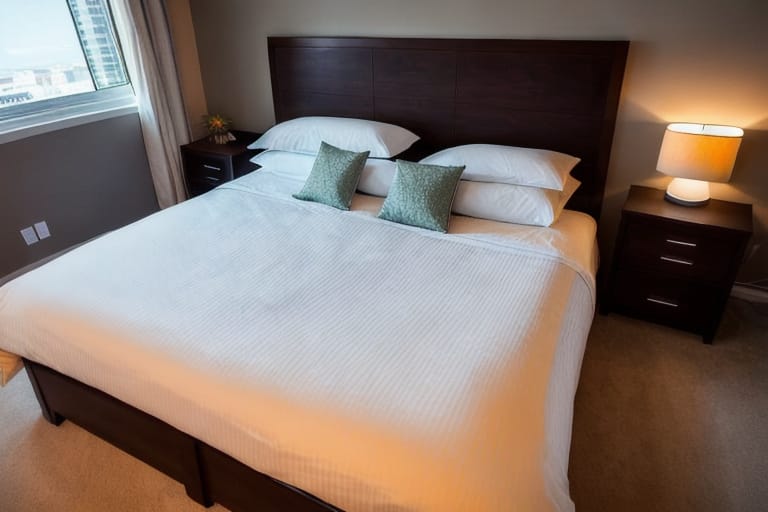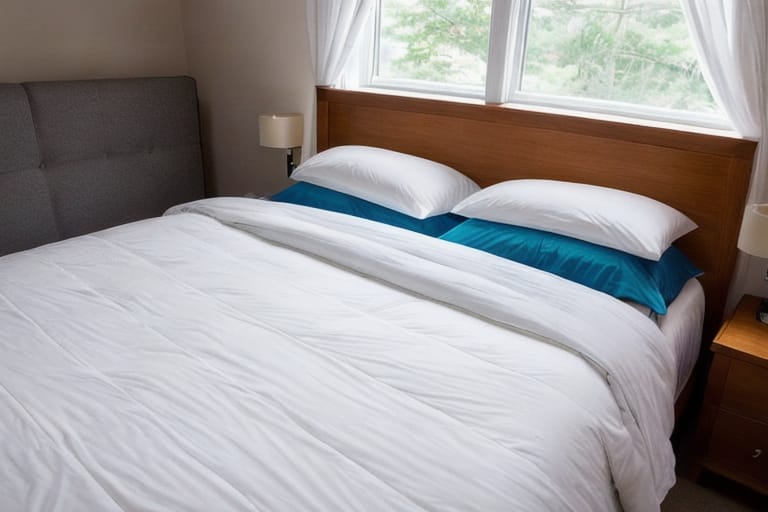Welcome to the wonderful world of down duvets! If you’re confused by all the options and terminology around duvet fillings, this guide will help you make an informed decision.
What Exactly Are Down Duvets?
Down duvets are duvets or comforters filled with natural down and feather fillings from ducks or geese. They are prized for exceptional warmth, softness, and comfort.
The fill power, fill weight, type of down, and construction quality all impact the warmth, fluffiness, breathability and longevity of the duvet.
Understanding the different factors will help you choose the perfect down duvet for your needs and budget.
The 7 Key Things that Define a Down Duvet
Here are the key criteria to evaluate when selecting a down duvet:
- Fill Power – This measures the loft or fluffiness of the downfilling. Higher fill powers above 600 provide more insulation.
- Fill Weight – The total weight of the down filling inside. Impacts overall warmth and coziness.
- Down Type – White down is highest quality, grey is decent too. Avoid brown or black down.
- Construction – Baffle boxes, stitching and thread counts impact durability.
- Warmth Ratings – Choose warmth suitable for your climate and seasons.
- Certifications – Responsible Down Standard (RDS) certifies humane treatment.
- Price – Higher quality materials and construction may cost more.
Next, let’s break these down in more detail…
Fill Power: Understanding Loft, Fluffiness & Insulation
Fill power is the key indicator of down quality and ability to trap body heat.
It measures the cubic inches per ounce that one ounce of down fills up.
Higher fill power down has better loft, expanding into more air pockets. This provides better insulation and warmth for its weight.
- Over 700 – Exceptional quality with premium warmth
- 600 to 700 – Great quality, perfect for very cold regions
- 500 to 600 – Decent quality, suitable for most climates
- Under 500 – Lower quality for milder regions and summer use
Pay attention to the fill power for the warmth level needed in your climate.
Fill Weight Explained
Fill weight refers to the total ounces of downfill inside the duvet. This gives a sense of the fluffiness, substance and overall coziness.
Lightweight options have less fill, providing less insulation. Choose heavier weights for extra plush comfort:
- Under 500 gsm – Lightweight, better for warmer climates
- 500 to 700 gsm – All-season warmth for most regions
- Over 700 gsm – Heavy, premium comfort in cold regions
Ideally, balance fill power and weight. For very cold winters, choose over 600 fill power and over 700 gsm weight.
Sorting Out Down Types
Down comes from ducks and geese. But not all down is equal in quality!
- White Down – Highest quality with excellent loft and insulation
- Grey Down – Also premium, nearly as good as white down
- Brown/Black Down – Lower quality, avoid if possible
White goose down is considered the gold standard – maximizing both softness and warmth.
Grey downs can provide great performance too at an affordable price point in some cases.
Construction Quality Counts
Beyond the filling, the construction impacts durability and longevity of your investment. Consider:
- Fabric Shell – Cotton, microfiber, cotton-poly blends are good options
- Baffle Boxes – Prevent fill from shifting, optimize warmth distribution
- Stitching – Look for tight, reinforced stitching every 6 to 12 inches
- Thread Count – 200-400 is decent, over 400 indicates premium quality
- Tabs/Loops – Help secure duvet inside cover
Higher thread counts and breathable fabrics like cotton or linen can improve comfort.

Warmth Ratings Guide
Down duvets are assigned warmth tog ratings to indicate which seasons they are suited for:
- 4.5+ tog – Warmest, ideal for frigid winters
- 3.5 to 4.5 tog – All-season warmth in most climates
- 1.5 to 3 tog – Lighter warmth for hot summers
Choose higher tog ratings if you sleep cold, live in a cold region, or use in winter.
If night sweats are an issue, pick lower-top options suited for hotter environments.
Responsible Down Standards
For ethical animal treatment, choose brands certified by the Responsible Down Standard (RDS).
RDS ensures humane practices for ducks and geese. This includes:
- No live-plucking
- No force-feeding
- Access to clean housing with space to roam
Sustainable down also helps the environment. IKEA and Patagonia down is RDS-approved for example.
Pricing Across Quality Levels
Like most home products, higher quality materials and manufacturing increases costs. Expect to invest more for premium down duvets with exceptional warmth, softness and durability:
| Quality | Sample Brands | Price Range |
|---|---|---|
| Budget | IKEA, Amazon | $50 – $150 |
| Mid-Range | Brooklinen, Buffy | $200 – $400 |
| Luxury | Feathered Friends, Snowe | $400+ |
Look for special sales around major holidays for some savings. Quality can still vary widely, so examine fill power and materials first when comparing options.
Differences: Down vs. Down Alternative Comforters
What about down alternative fillings from synthetic materials?
Down alternatives like microfiber polyester fill mimic properties of natural down, but tend to be less expensive.
However, alternatives usually don’t match the cloud-like coziness, lasting durability and breathability of high-grade down.
Down alternatives can also lack the certification processes upholding humane and sustainable standards that the best down can provide.
Still, if selecting down alternatives, check the “fill power” rating and densities over 50 ounces per square yard for reasonable performance.
Expert Tips for Choosing the Best Down Duvet
Sleep experts and bedding professionals provide recommendations:
“Choose the highest fill power that fits your budget for warmth plus plush comfort.”
“Give the baffle boxes a look – these help evenly distribute fill for consistent coziness.”
“Be sure to match the duvet’s warmth rating to your climate and seasons.”
“Check certifications to verify responsible sourcing methods.”
Reputable brands like Feathered Friends and Snowe also rate highly for premium materials, attention to detail, and responsive customer service.
Caring for Your Down Duvet
With proper maintenance, a quality down duvet can last over 10 years!
- Dry Clean Annually – Best practice to sanitize filling
- Wash Duvet Cover – Every 1-2 weeks is ideal
- Natural Airing – Air out down 2-3 times per year
- Proper Storage – Fold loosely when not in use to preserve loft
Stick to mild detergents and gentle cycles for both duvet and duvet covers to avoid down damage over time.
Current Innovations in Down Bedding
While down itself remains the gold standard for warmth and softness, some brands are now augmenting down with innovative materials:
- PrimaLoft insulation – Maintains warmth even when wet
- Temperature regulating fibers – Prevent overheating
- Moisture wicking fabrics – Improve breathability
Others focus on sustainability – for example, reusing down and feathers from discarded bedding that would otherwise be wastefully sent to landfills.
Takeaways on Down Duvets
- Understand key measures like fill power, fill weight and down types
- Match warmth ratings to climate needs
- Verify responsible sourcing standards
- Choose quality construction for durability
- Properly maintain with annual dry cleaning
While upgrading bedding represents an investment, the years of restful sleep and cozy comfort a quality down duvet delivers makes it worthwhile.

Frequently Asked Questions
What’s the ideal down comforter fill power for year-round use?
The best fill power for a down comforter that provides year-round warmth for most climates is 600 to 700 fill power. This delivers great loft and insulation without being overly stifling in warmer months.
How does down cluster size impact down comforter quality?
Larger down clusters have greater lofting power and contribute most towards insulation, fluffiness and durability. High quality down comforters should consist predominantly of large, fluffy down clusters and very few small down particles.
Does down comforter fill power or weight matter more?
They are both very important and work hand-in-hand! Materials with higher fill power provide better insulation and loft, trapping more dead air space which boosts warmth. Fill weight then determines the overall amount used to provide that warmth. So balance fill power and weight appropriately for your needs.
Are alternative down comforters with microfiber just as good as real down?
The best down alternative comforters provide decent performance and more economical pricing. However, alternatives usually don’t match the exceptional warmth, breathability and lasting durability of high-grade goose down or other real natural downs, especially over many years.
Is it better to get a lightweight or heavyweight comforter for winter?
Choose a heavyweight comforter rated at least 13.5 oz (over 680 gsm) fill weight or more for maximum warmth in cold winter climates. Pair this with a higher fill power over 600 for adequate insulation and loft. Going with a lightweight winter comforter often requires uncomfortable additional blankets.








